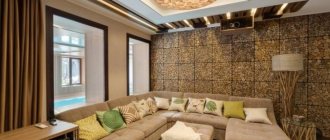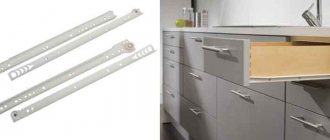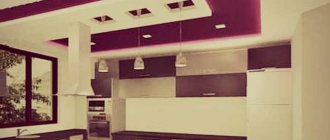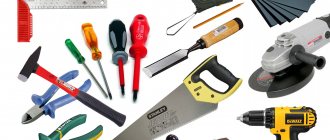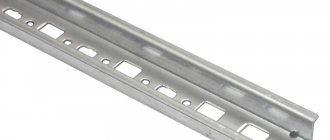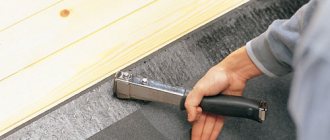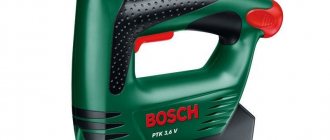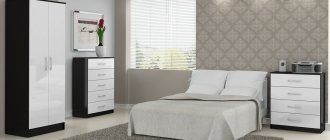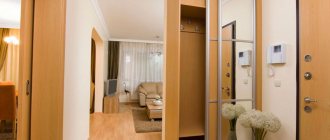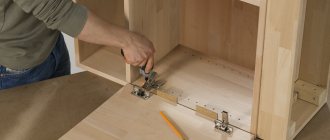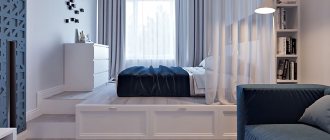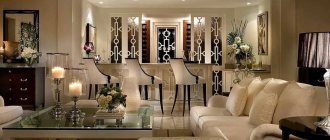Furniture screed is used only in furniture production. When making furniture, you should not use traditional fasteners instead of furniture ties, because it has special properties that not only facilitate the assembly of furniture, but also allow you to hide the fasteners. Next, we will consider the most commonly used types of furniture screeds and their features.
Confirmat
The most common type of fastener is confirmat. At the same time the easiest to use. With its help, assembling furniture is easier and faster than using other types of furniture screed. Especially if during assembly you have to drill holes for fasteners yourself. Using a confirmat, two parts are connected at an angle of 90 degrees.
Fig.1.
Confirmat - used to connect parts at an angle of 90 degrees. The two parts are connected with 2 confirmed screws. The confirmat is installed at a distance of 3-7 cm from the end of the parts to be connected. To install 1 confirmation screw, you must first drill 2 holes in the parts to be joined: in the end of the first part for threads (drill diameter 5 mm), in the second part for the head (drill diameter 6 mm).
In order to tighten the two parts, you need to drill two holes. One in one part, with a diameter equal to the diameter of the confirmator head, the other, at the end of the second part, with a smaller diameter equal to the diameter of the threaded part.
As a rule, drills with a diameter of 6 and 5 mm are used for this, respectively. However, there is a combination drill available for drilling holes at the same time. It is very comfortable. There is no need to constantly rearrange drill bits or use two drills at the same time.
Fig.2.
Drill for confirmation. Allows you to make a hole for 1 confirmat screw in two parts at once, and also forms a recess for the confirmat head. Increases the speed of furniture assembly by at least 50%.
Confirmat is a universal fastener, but it has some disadvantages and application features.
Confirmat should be used simultaneously with the use of dowels. A dowel is a wooden rod with a diameter of 6-8 mm and a length of 20-30 mm (in the photo below, next to the confirmation). The dowel acts as a guide and does not allow parts to move during tightening.
Fig.3.
Connecting the parts using a dowel with a diameter of 6-8 mm and a confirmat. This joining method is used in factory furniture, for example furniture from IKEA. Provides high accuracy of joining parts.
Despite the fact that furniture assembled using confiramate can be assembled or disassembled, furniture made from laminated chipboard does not tolerate this very well. As a rule, after one disassembly, the furniture screed no longer holds well.
The confirmation should be wrapped carefully. The best option is by hand or with a screwdriver at low speed. Otherwise, the confirmation thread turns into a drill, which breaks the hole.
Fig.4.
Tightening of parts with confirmation. The tie is performed with a hand wrench or a screwdriver with a low rotation speed of the chuck. The screwdriver must have the correct tightening torque to prevent thread stripping.
In order to recess the head into the body of the furniture part, you should use a wrench and do it carefully, otherwise there is a possibility of the thread breaking. Sometimes it is necessary to pre-calculate.
Con fasteners. Those. Unlike other types of fasteners, it remains visible, so it is necessary to use special plugs or stickers to hide the fasteners.
Fig.5.
Plastic plugs (linings). Used to hide the confirmat's cap. They are attached to the confirmation cap in the key groove and are held in place by a specially shaped core. Available in various colors.
Fig.6.
Self-adhesive overlays for confirmat. Designed to hide the cap. They have a wide range of colors, completely identical to chipboard panels. Almost invisible on furniture.
No. 5. Strength class
The grade of steel and the characteristics of its processing determine the strength class of the finished product. According to regulatory documents, 11 strength classes are defined, here are some of them: 3.6, 4.6, 5.6, ..., 10.9, 12.9. It's easy to decipher these numbers:
- the number before the decimal point (dot) indicates the tensile strength, N/mm2. We will get the exact value if we multiply the number by 100. For a bolt of strength class 4.6 it will be 4*100=400 N/mm2;
- the number after the decimal point is the ratio of the yield moment to the tensile strength, expressed as a percentage. For the same 4.6 bolt, this parameter will be 60%. The yield strength is considered to be the load that causes irreversible deformation of the product.
In the furniture industry, bolts from class 4.6 to 12.9 are used. The most popular are hardware of classes 4.6, 5.6, 5.8, 6.6 and 6.8. However, if you have to fasten critical parts, then you need to use 8.8 bolts. They are called high-strength . In general, all fasteners that can withstand 800 N/mm2 or more are called high-strength. Furniture bolts of even higher strength are much less common on sale and are more expensive.
Low-strength bolts are usually made by turning. For more durable products, volumetric stamping is used, and the most durable ones are also hardened.
Eccentric coupler
An eccentric coupler is often used in the factory production of furniture. The reason for this is the difficulty of drilling holes. An eccentric coupler consists of two parts: a pin and an eccentric. The pin is installed in one part, and the eccentric in another.
Fig.7.
An eccentric coupler is used to conceal the connection of two parts at an angle of 90 degrees. To connect 2 parts you need 2 eccentric couplers. The eccentric coupler is installed at a distance of 5 cm from the end of the parts to be connected. To install the eccentric coupler, you need to drill several holes according to the diagram. Instead of a rod with a length of 34, a rod with a length of 26 mm (shortened) can be used, while the remaining dimensions remain unchanged.
The main advantage of this type of fastener is that this fastener is hidden and therefore does not spoil the appearance of the furniture. In addition, this type of fastener, unlike confirmat, allows you to repeatedly assemble and disassemble furniture, which is important, for example, when moving. Also, using an eccentric coupler, you can connect parts at different angles.
When making furniture yourself, it is not often used due to the difficulty of drilling holes and the inability to correct the joint during assembly. The main difficulty in drilling holes lies in the hole for the eccentric. This hole is not through and requires the use of a special drill - a Forstner drill.
Fig.8.
Forstner drill - used for milling blind holes for an eccentric. For a standard eccentric, a drill with a diameter of 15 mm is required.
Fig.9.
Hole for eccentric. First, mark the part according to the diagram given above. Next, use a Forstner drill to make a hole for the eccentric. Then, using a drill with a diameter of 8 mm, a hole is drilled in the end of the part for the rod.
Fig. 10.
Scheme of connecting parts using an eccentric coupler. First, the rod is installed in one part and the eccentric in another. Then the parts are connected and fixed by turning the eccentric clockwise through an angle of 180 degrees.
In this case, the sampling depth is about 12 mm, and the thickness of the chipboard is 16 mm. The remaining wall thickness is only 4 mm. There is a risk of drilling more than necessary, thereby damaging the piece of furniture. Therefore, when drilling holes for an eccentric tie, it is necessary to use drilling depth limiters.
Fig. 11.
Stopper for drilling holes for eccentric tie rods. Allows you to make a hole of a fixed depth. Protects furniture parts from damage when drilling.
The nuances of placing fasteners when marking chipboard parts
At the design stage of the wardrobe body, they try to plan the internal content in such a way that the visible sides have a minimum of through holes. After all, even if you seal the hats of the confirmations with self-adhesive plugs, they will be visible and this will somewhat “cheapen” the appearance of the furniture. This can be done in several ways:
- Design open niches on the sides of the wardrobe for installing rods and pantographs for hangers with clothes.
- Most shelves are secured not rigidly, but using shelf holders.
- To rigidly fasten shelves, use eccentrics and dowels rather than confirmats.
When preliminary marking the drilling sites for fasteners, use the “32 system”, and the same distance is retreated from the edge (for example, 50mm). This allows you to automate the process of preliminary addition of parts for further assembly and eliminate errors as much as possible.
Intersectional screed
This tie is a screw and nut with which two sections of furniture are pulled together, for example, two cabinets. To tie cabinets, 2 - 4 intersectional ties are used. Depending on the thickness of the chipboard, there are intersection screeds of various sizes.
Fig. 12.
Intersectional screed is designed to connect cabinets (sections) of furniture to each other. To tie 2 cabinets you need 3-4 intersection ties. The intersectional screed is installed near the corners (at a distance of 3-5 cm from the end) of the sections being connected.
Considering that the intersection screed is used to tie cabinets, and the cabinets, in turn, are made of laminated chipboard with a thickness of 16 mm, an intersection screed with a length of 32 mm is most often used. However, there are ties up to 50 mm long, which are used to tighten parts of greater thickness.
Fig. 13.
Screeding cabinets with an intersectional screed. To install the screed, you need to secure the cabinets using clamps. Next, make a hole with a diameter of 9 mm (1 mm larger than the diameter of the tie). Then install and secure the screed.
Types of Pin Connections
We differentiate between blunt connecting pins, straight connecting pins and angled connecting pins.
- For corner connections, straight or corner pins are used. They are mainly made from beech wood, with a diameter of 6 to 20 millimeters, with a smooth or already grooved surface.
- Ideally, the pin should be a harder wood than the material being joined. The finished pins already have chamfered ends to make it easier to work with during connection.
- If you are making the pins yourself, also carefully cut off both ends and sand them. Slotted pins can be straight or spiral and are called grooved pins.
Due to the expanding properties of wood, the pin is held very tightly. In addition, the grooves allow the pin to be distributed more evenly across the entire pin area when using adhesive.
Shelf supports
There are a huge number of types of shelf supports. However, they can be divided into two groups: shelf holders for chipboards and shelf holders for glass. In turn, each of these groups can be divided into two types: shelf holders with and without fixation.
The shelf holder for chipboard consists of 2 parts: a rod and a shelf holder.
Fig. 14.
The shelf holder for laminated chipboard is designed for reliable fastening of shelves in the closet. Available in two types, with and without fixation. Fixation is ensured by an eccentric. The shelf holder is installed in the shelf, the rod in the cabinet wall. To attach 1 shelf you need 4 shelf supports.
The screw is installed in the cabinet wall, and the shelf holder is installed in the body of the shelf. To install the shelf holder, you need to drill holes in the shelf and cabinet wall. For most shelf supports, the hole sizes are standardized; they are shown in the figure below. However, when installing the shelf support, you should carefully read the instructions to avoid errors.
Fig. 15.
Hole pattern for shelf holders for chipboard. A hole is made in the shelf with a Forstner drill for installing the holder. There is a hole in the wall for the rod using a wood drill. The shelf holders are located at a distance of 5 cm from the front and rear ends of the shelf.
Next, the shelf holder is installed in the prepared hole. To do this you need to use a rubber hammer. This way the shelf holder will be firmly fixed in the shelf.
It should be noted that shelf holders for chipboard come with or without fixation. The shelf holder with fixation has an eccentric mechanism, thanks to which the shelf will be firmly connected to the cabinet wall. Shelf supports with fixation have one more advantage; shelf supports of this type serve as additional reinforcement of the furniture structure.
Fig. 16.
Shelf holder for chipboard with fixation. Analogue of an eccentric coupler. Additionally strengthens the structure of the furniture and increases the rigidity of the cabinet. The shelf holder provides the ability to remove and rearrange the shelf many times without damaging the furniture.
Glass shelf holders have a simpler design. They are attached only to the cabinet walls using a self-tapping screw.
Fig. 17.
Shelf holder for glass. To install 1 glass shelf you need 4 shelf holders. The shelf holders are secured with self-tapping screws 16 mm long to the cabinet walls at a distance of 5 cm from the front and rear ends of the cabinet.
Shelf holders for glass without fixation are a rod or an angle. Shelf holders with fixation have a special screw with which the glass is firmly fixed and cannot accidentally fall out.
Fig. 18.
Shelf holder for glass. The glass is fixed with a screw on the bottom side of the shelf holder.
Facades
In a furniture design, all visible parts that face the front or side plane are called facades. Their configuration and color determine the style of the furniture and set the tone for the entire room.
Main types of facades:
- Doors;
- Front walls of drawers;
- Horizontal and vertical decorative overlays;
- Furniture cornices.
The facade can be easily unfastened from the attachment fastening, replaced with a new one and adjusted in vertical, horizontal and inclined positions. Various circumstances lead to the replacement of facade elements ─ careless use, mechanical damage, outdated design, discoloration of the structure due to exposure to ultraviolet radiation. To make furniture with your own hands, they use solid ─ “blind” and prefabricated frame-paneled facade elements.
Most often used for the production of facades:
- Chipboard;
- MDF board;
- Natural wood (solid);
- Furniture board;
- Metal (stainless steel, aluminum);
- Glass.
Budget furniture is made from laminated chipboard. MDF boards make beautiful structures finished with film, paneling or veneer.
Premium products include elements made from natural wood. Today the market offers modern facades made of aluminum profiles. It looks organically with glass, plastic, rattan and other materials. To fill the profiles, genuine leather, textile fibers, and polymer 3D photo printing are used.
Chipboard
Glass
MDF
Furniture board
Natural wood
Metal
Table top screed
A special type of screed is required to connect two parts of a table top. Used in the manufacture of kitchen furniture.
Fig. 19.
Screed for table tops. Provides a reliable connection between two parts of countertops. To increase the accuracy of joining parts, it is advisable to use it together with a dowel. For a standard screed, non-through holes with a diameter of 35 mm and a depth of 19 mm are made in the connected parts of the tabletops. The distance between the holes should be 15 mm less than the length of the tie. The groove width must be at least 7 mm.
To tie two tabletops together, use a pair of ties. To install the tie rods, it is necessary to make recesses for the tie rod stops and a slot for the screw. This can be done in various ways. The most affordable option is the following. The recess for the stops is made with a Forstner drill of a suitable diameter; the slot for the screw can be made using a jigsaw.
Fig.20.
Connecting table tops with a screed. At least 2 ties are installed for connection. To install the screed, holes and a groove are milled in the tabletop slab. The holes can be made with a Forstner drill, the groove can be cut out with a chisel, or using a hand router.
Scope of application
The main purpose of the screw is to connect various furniture elements (tabletops, wall sections, etc.) to each other. The popularity of such fasteners is associated with reliability, convenient installation and low cost. It allows:
- connect chipboard sheets together;
- assemble frames of beds, sofas, armchairs and other structures;
- fix massive wood elements.
Some fasteners only perform one function. For example, shelf holders are designed to hold shelves - almost no modern cabinet or kitchen set today can do without such an element. In addition to furniture production, screws are actively used in many sectors of the national economy to solve everyday problems.
Joining chipboard sheets
Assembling the furniture frame
Fixing massive elements
Furniture corner
This type of fastener is used to connect two parts. This is a rather fragile connection method, so it is used to fasten parts that are not expected to be affected by heavy loads. Usually these are decorative elements, for example, the base of a wardrobe or mezzanine shelves.
Fig.21.
The furniture corner is used for fastening decorative furniture elements (plinth) and installing shelves. Made from plastic. It has a cover to hide the fasteners. Self-tapping screws 16 mm long are used as fasteners.
Plastic corners are often used instead of metal ones. They are no less durable, but have a more attractive appearance and the possibility of hidden fasteners. The furniture corner is attached to two mating parts using two self-tapping screws. Then the lid is snapped on, thus hiding the fasteners.
Fig.22.
A furniture corner is used for fastening low-load furniture elements, including for installing decorative elements such as a plinth, inserts, etc.
The furniture fasteners discussed in the article are the most common and most frequently used, due to the fact that these are the most versatile and easy-to-use types of fasteners. In the vast majority of cases, the types of furniture fasteners described are sufficient to assemble any furniture.
Types, depending on the material to which it is attached
Modern manufacturers today use not only chipboard to make furniture. Glass, metal parts, and plastic elements are widely used. Fastenings for furniture made of chipboard were discussed throughout the material, and options for fastening objects made from other raw materials are discussed below:
- Glass - screw-type holders are used that are screwed into a wall made of concrete or plasterboard. They are used to fix shelves and mirror surfaces without damaging the coating of the part. For glass doors on the cabinet, the use of furniture hinges is suitable;
- Metal – screw fastenings are used to connect the shelves of metal racks. They are screwed into the racks using a drill or screwdriver. An attractive cap is installed on the front side;
- Plastic – plastic parts can be secured using any chipboard fasteners.
Separately, it is worth highlighting the dovetail fastening - it is used to connect drawers. The essence of the connection is to cut out a comb surface on each part, which is inserted into another part, resulting in end-to-end fixation. Choose only the type of fastening that suits you best. Before purchasing, be sure to calculate the thickness of the material so that during the assembly process screws and screws do not protrude on the surface.
For plastic
For glass
For metal
How the price of wood products is determined
The price of our solid wood products at Dilect consists of the following factors
Type of tree
Products are made from different types of wood, which differ in appearance, quality characteristics and, accordingly, price.
Product dimensions
Products are made from different types of wood, which differ in appearance, quality characteristics and, accordingly, price.
Preparation method
The furniture panel can be solid-lamella or spliced. The first option is noticeably more expensive than the second.
And at the same time, the developed methodology, precise manufacturing, and compliance with technological standards allow us to produce spliced products with the best characteristics and aesthetic properties.
Number of varieties
Number of wood types for the product
Types of fasteners
Furniture ties can be used individually or in combination with others. Some furniture items are designed for special occasions. It makes sense to consider the features of each and the principle of its installation.
You might be interested in:
- Online furniture store Alanamebel.ru
- Industrial mountaineering and reasons to choose it
- What to do if you need to get a loan?
- Single-leaf plastic windows
- What is the difference between artificial and natural rattan furniture?
- Diesel generator
- Projects of attic houses
- Principles for creating public transport stops
Screw classification
Let us now consider the screws available in the TsKI assortment. The largest group of them are general purpose screws. We meet them every day in everyday life and at work. They all have a fully threaded shaft (although there are exceptions) and different shaped heads. The heads have slots or recesses for different types of keys.
Another large group of screws are set screws. The name comes from their purpose. For the most part, they are designed for precise installation and fixation of parts in mechanisms. To do this, they have various protrusions or recesses at their ends.
According to GOST 12414-94 (ISO 4753:1999): “Ends of bolts, screws and studs. Dimensions" the following setscrew ends are provided:
The torque is driven by the following elements:
The summary table shows the actual, most common combinations of setscrew heads and ends, indicating the DIN standard.
Advantages of rod fittings
After the advent of Euroscrews, furniture assembly became more reliable and of higher quality. Unlike previously installed screws, these parts have several positive characteristics:
- Tightly tighten all parts.
- Easy installation.
- High-quality coupling of parts.
- The screws can be connected to each other.
- The design on such screws is capable of withstanding heavy loads throughout the entire period of operation. To secure the bookshelf, a dowel is installed together with the confirmation.
Unfortunately, such devices also have a number of characteristic disadvantages. These include:
- Assembling furniture with such screws can only be done once. This design is not intended for frequent disassembly.
- The screw head does not belong to the group of “hidden” systems. Therefore, in order to hide it, you have to install plastic plugs, the color of which is selected according to the shade of the furniture.
Characteristic structural differences
These screws have a countersunk head equipped with various slots. This allows you to tighten parts with screwdrivers with four and six edges. The working part of the rod with a blunt end has a protruding thread. Its lower turns must cut a thread, so they are made of a conical shape with notches. There are no threads on the surface under the head, it looks absolutely smooth.
To create anti-corrosion protection, parts are galvanized. In most cases, a zinc surface is found. Special carbon steel gives such products high ductility. That's why they never break, they can only be bent. Thanks to this plasticity, the Euroscrew is easy to remove from the product, even if its installation was done incorrectly.
The design of confirmations has several differences. Parts with a regular head are installed after preliminary countersinking of the hole. Some screws have a special tooth right under the head. It forms a chamfer to position the cap.
Plugs for Euroscrews
When the confirmation cap is located on the outside of the product, decorative plugs are used to disguise it. They completely cover the cap, and a well-chosen color creates a complete look for the structure.
The industry produces several types of plugs. The most popular and in demand are:
When selecting the appropriate type of cap, the shade of the chipboard must be taken into account. True, choosing the exact color is very difficult. Therefore, self-adhesive products have become the most popular. They are colorless and made from melamine. The thickness of this film is 0.4 mm, so it becomes invisible on the furniture surface.
Plastic plugs are made of durable plastic. They have a round shape with a diameter of 1.2 cm. The products are fixed by the hexagonal protrusion left by the screw when tightened.
Main dimensions of Euroscrews
The industry produces a confirmat, the dimensions of which allow the assembly of a wide variety of structures. The line of such screeds includes:
- 5.00 x 40.00 mm;
- 5.00 x 50.00 mm;
- 6.30 x 40.00 mm;
- 6.30 x 50.00 mm;
- 7.00 x 40.00 mm;
- 7.00 x 50.00 mm;
- 7.00 x 60.00 mm;
- 7.00 x 70.00 mm.
The first number shows the thread diameter. The second indicates the length of the screw. The most popular is the confirmat size 7x50.
